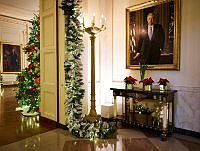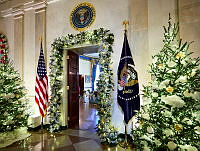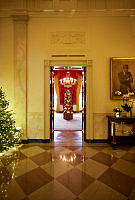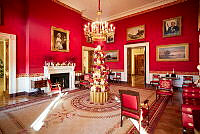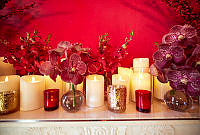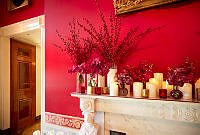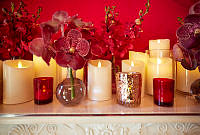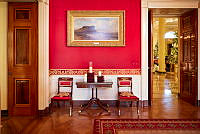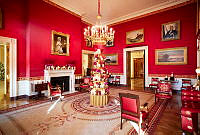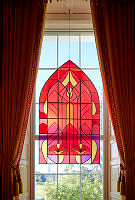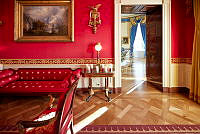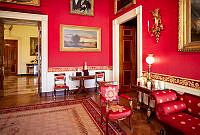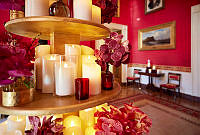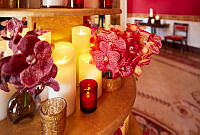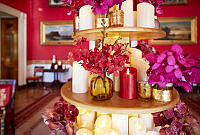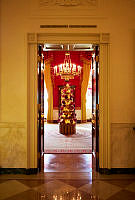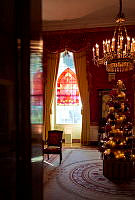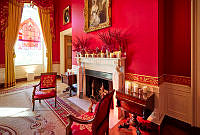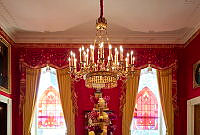Reflections After the Fire
The History of the Monroe Shaving Mirrors
Copyright © Summer 2014 White House Historical Association. All rights reserved under international copyright conventions. No part of this article may be reproduced or utilized in any form or by any means, electronic or mechanical, including photocopying, recording, or by any information storage and retrieval system, without permission in writing from the publisher. Requests for reprint permissions should be addressed to books@whha.org

This shaving mirror is one of a pair created from fragments of mirror glass that survived the White House fire. Dolley Madison and Elizabeth Monroe discovered and salvaged the glass.
Bruce M. White for the White House Historical AssociationThis shaving mirror, one of a pair, has a remarkable history. It not only reflected the face of President James Monroe but may have been a witness to the flames that engulfed the White House in August 1814. According to Monroe family history, Elizabeth Monroe and Dolley Madison were walking the grounds of the White House in 1816 when they spotted large shards of glass in a trench.1 Even though two years had passed since the White House was burned during the British invasion, the work of clearing the aftermath of the fire and reconstructing the President’s House was still going on, and workers were dumping debris from the house into a nearby trench.2
Wishing to preserve the discarded glass, the two women asked workers to retrieve several pieces for them. Years later, Elizabeth Monroe had the glass put into two frames to function as shaving mirrors. She felt that these two mirrors represented both the “new and old” eras of the White House, referring to the transition from the Madison administration to the Monroe administration. Although it is uncertain whether or not one of the mirrors was intended for James Madison, both remained in the Monroe family, and tradition states that James Monroe used one of the mirrors at his retirement home, Oak Hill, in Loudoun County, Virginia. While the origins of the glass before they were retrieved from the trench are unknown, the large overmantel mirror designed by Benjamin H. Latrobe for the “Elliptical Saloon,” today known as the Blue Room, would have created shards large enough for this mirror and plenty of romantic association as well.3 Latrobe had great difficulty in finding mirror glass that large and may have pieced the White House glass to achieve the desired size. Today, one of the shaving mirrors is at the James Monroe Museum and Memorial Library in Fredericksburg, Virginia, and the other is currently on loan and being displayed at Ash Lawn–Highland, Monroe’s home near Charlottesville, Virginia.

Benjamin Labrobe’s drawing for the “Looking glass frame, Presidents’ house.” If the glass used in the Monroe mirrors came from the White House, it may have been fragments from this mirror, which was lost in the fire.
Library of CongressAlthough several artifacts were saved from the White House before the fire, very little was salvaged afterward. Madison’s steward, Jean-Pierre Sioussat, who was paid by the government to search the ruins for what might be saved, did salvage Jefferson’s kitchen range and a few pots and pans, but nothing else of significance seems to have been saved.4 The extent of the damage was large, and very little that had been inside the White House was reclaimable. William Lee, who was responsible for refurnishing the White House, stated that “there was no recourse in the remnants of glass, earthenware, china, linen, etc. of which scarcely an article would serve, indeed we may say there remained none of these articles fit for use.”5 Therefore, because these mirrors were salvaged after the British burned Washington, they represent rare objects of early White House history.
While an unpublished 1977 archaeological analysis of White House grounds cannot confirm the mirrors’ history entirely, it does add an interesting piece to the puzzle. In 1975, excavation began in order to clear the way for a swimming pool for President Gerald R. Ford. As work on the pool continued, it quickly became clear that the area might have been previously used as a trash pit. With the support of individuals of the National Park Service who were interested in studying these remnants, the soil was moved off White House grounds, and this huge pile of dirt became the object of sifting and study in the 1977 report.6
Although the report was considered incomplete even by the author,
Professor J. M. Young, the study confirmed that the soil contained early
nineteenth-century artifacts such as Chinese export wares, and English
and French ceramics, and glass.
7 Some
of the china found depicted the Madisons’ familiar monogram, confirming
that the area had been used during the Madison presidency as a trash
pit.
8 Building materials
such as brick, slate roof tiles, mortar, nails, and even burned wood
turned up. Young felt that it was difficult to date these materials and
did not speculate on their age,
9
therefore making it now impossible to conclude, other than
circumstantially, that the building materials actually came from the
remnants of the burned White House. But it is very likely that they did,
filling a gulley that appeared before the fire on early maps and
disappeared later on. Workers who rebuilt the White House used the area
as a dump and installed a privy there and pieces of the Madisons’ China
was found there, as stated above. Although no mirror glass is listed in
the report,
10 it is not unreasonable
to believe that the mirror glass was also dumped there originally, since
Mrs. Madison and Mrs. Monroe had already removed the glass.

President Gerald R. Ford and his daughter Susan observe the work in progress as a hole is excavated for the installation of a swimming pool on the White House grounds, May 20, 1975.
Gerald R. Ford Presidential Library and Museum/NARAThe Monroe shaving mirrors are made of mahogany, glass, and brass and are an example of an American Empire swing-style frame. The angle of the mirror is adjustable, and wing nuts on the stand can be tightened to keep the mirror at the desired angle. 11 The stand of both mirrors tapers slightly down to the trestle base. The frame of the mirror very much resembles a picture frame and is more elaborate than the stand itself. Such molded frames were popular in rural areas in the eighteenth and nineteenth centuries, 12 and although the maker is unknown, the frames may have been made in a rural area. Some damage is present. There is a large gouge on the left foot of the mirror at the James Monroe Museum and Memorial Library, and wear from use is evident, but the near-perfect mortar and tenon construction indicates the frame was made by a skilled woodworker. These mirrors were probably created between 1825 and 1830, just before Elizabeth Monroe’s death in 1830. 13 Their provenance states that the mirrors passed to the Monroes’ younger daughter, Maria Hester Monroe, and eventually were a gift from the Hoes family to the James Monroe Memorial Foundation.14
Not only do the mirrors represent an interesting aspect of White House history; they also capture an important time for the history of glass. Looking glasses had gained great popularity in the 1790s and were considered expensive objects and treasured possessions. 15 The Monroe mirrors also represent a new type of adjustable looking glass in the nineteenth century. In The Cabinet-Maker and Upholsterer’s Drawing-Book published first in 1793, Thomas Sheraton describes the full-length “horse,” or cheval, glass, which works just as this smaller shaving glass does, with the mirror fixed in the center of the frame “so as to move in any position either back or forward.” 16 Although these types of mirrors had been made in England since the Queen Anne period, American examples during the Queen Anne and Chippendale eras are scarce. However, swinging glasses with or without drawers were advertised in Boston as early as 1735. 17 The majority of freestanding American glasses were made in the Federal period, right before the making of the Monroe mirrors, and by the time these were made dressing glasses were quickly starting to become permanently attached to the dressing chest. 18 Swing mirrors had lost their popularity by 1840 because they often did not stay secured at the desired angle. Larger mirrors could just as easily hang on the wall, which kept them stationary and eliminated the problems of the swing mirror. 19 The Monroe mirrors therefore represent a type of mirror current for only a short time: a mirror that was on a stand, adjustable but free from the dressing table. The full history of Monroe shaving mirrors remains unclear, but both give us more than one thing to consider. As we reflect upon these mirrors, we see highly treasured objects of the Monroe family, a popular furniture form of the early nineteenth century, and rare survivals of the burning of the White House.














